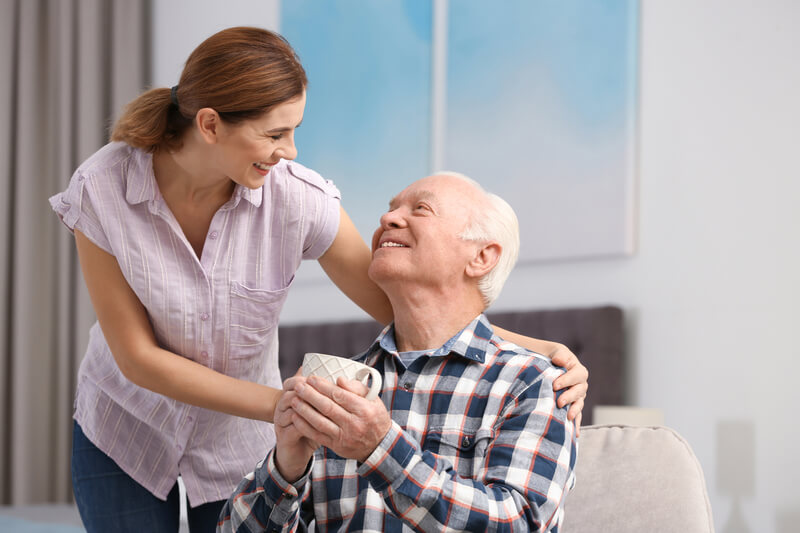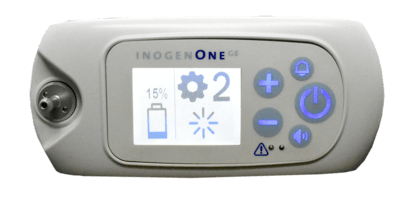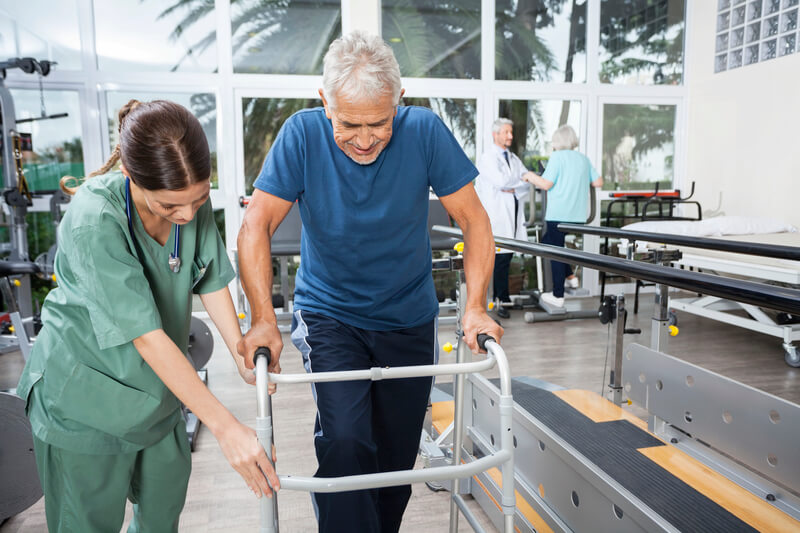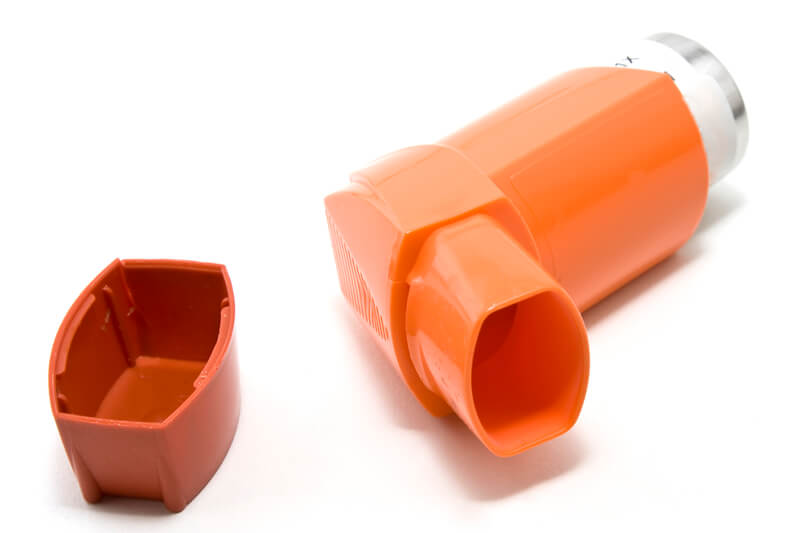.png)
Chronic obstructive pulmonary disease (COPD) affects millions of people around the world. It’s a lung disease characterized by difficulty breathing, coughing, wheezing, chest pain, and more. While there is no cure for COPD, its symptoms can be reduced significantly by following a strict treatment plan designed by your doctor.
In our blog, we’ve discussed many topics about living with COPD such as shopping and cooking, completing household chores, and even living a more fulfilling life. But what about COPD patients who aren’t able to do these daily tasks without help? After all, COPD is a debilitating disease and for many people, doing the things they once could are simply no longer possible — this is where caregivers come in.
While you may think of a caregiver as someone hired by a home healthcare company, in reality, most caregivers are friends or family members who take time out of their busy day to help a loved one. Oftentimes, caregivers are people who are working full-time or part-time jobs, have kids, a spouse, or other commitments to attend to, so if you’re thinking of taking on the role of a caregiver, you need to be able to manage your time effectively.
Unfortunately, for this type of caregiver, there is no type of training to help prepare you for the task ahead. Being a caregiver means taking things one day at a time and adapting to the needs of your loved one as they age and their condition changes. At the same time, it’s important that you don’t forget the relationship you have with this person. In other words, just because you’re caring for someone doesn’t mean you can’t still be their son, daughter, grand kid, or friend.
In the following sections, we’re going to discuss the importance of caregiving for COPD patients, what you should know to get started, and some helpful tips to manage your time more effectively. It’s important to remember that you’re not alone in becoming a caregiver. According to the COPD Foundation, there are 65 million family caregivers nationwide who spend 20 hours a week on average caring for a loved one, so if you have any questions, consult online forums like AgingCare or speak with a pulmonary specialist.
Getting Started as a Caregiver for COPD
For many people looking to help a friend or loved one through caregiving, knowing where to get started can often be the hardest part. While you want to provide them with the best care you can, you still have your own life to manage, so finding the right balance should always be your first step.
Determine If You’re The Right Fit
One thing you should immediately ask yourself when presented with the prospect of caregiving for someone with COPD is, “Am I the right fit?” While you may be fully capable of taking on the challenge, that doesn’t necessarily mean your busy life will allow it.
Many people have children to raise, jobs to work, or other tasks to attend to, so the more honest you can be to yourself and your loved one about the feasibility of becoming a caregiver, the better. It’s best to find an alternative now rather than realizing three or four months in that you won’t be able to take care of them. Chances are, if it means sacrificing your relationships with friends, family members, or your job security, then finding another option is not out of the question.

Start by reaching out to home care providers in your area. While in-home care can be expensive, you need to consider all your options and remember that many health insurance companies, including Medicare, cover some form of home health services. Depending on your specific needs, it may be covered through either Part A or Part B of Medicare and includes care provided by a home health aide, therapy, and intermittent skilled nursing care.
It’s unlikely that you will get reimbursement from your health insurance if your loved one isn’t homebound, meaning they aren’t able to leave the home without extreme difficulty. Another thing to note is that you will need a signed home health certification from your doctor in order to be covered. If you’d like to learn more about this process, visit Medicare Interactive’s home health services page.
Allocating Your Time
Now that you’ve taken the time to consider hiring a home care provider, you need to start allocating time on your schedule. If you’ve hired a home care professional, you may only need to be there with them for a certain period of time each day. At this point, it’s just about finding this time in your schedule and making sure people are aware that you won’t be available during those times.

Staying organized will make all the difference in the world when you become a caregiver because it will ensure that you’re always prepared for whatever challenges you may face. If you’re organized, you’ll be able to more easily schedule doctors appointments, make yourself available for emergencies, and ensure your loved one is attended to when they need it.
{{cta('fa8abc2a-1e88-4fa3-82fd-1cb5b9ed43b2','justifycenter')}}
Doing Your Research
Researching COPD is one of the most important steps when preparing to be a caregiver. Generally speaking, the more educated you are about the disease and its unique symptoms, the better prepared you will be to deal with emergencies associated with it. There are two forms of COPD, emphysema and chronic bronchitis.
.jpg)
Emphysema
In the lungs, there are tiny air sacs called alveoli. Oxygen passes through the alveoli walls and enters the bloodstream when you breath. However, in someone with emphysema, these tiny air sacs are damaged and they’re less efficient at transferring oxygen to the blood. This results in symptoms like low blood oxygen levels, shortness of breath, persistent cough, fatigue, and excessive mucus production.
Chronic Bronchitis
Although chronic bronchitis has similar symptoms to emphysema, it’s a condition that damages the bronchi, the tubes that carry oxygen into the lungs. While the main symptom of emphysema is shortness of breath, the main symptom of chronic bronchitis is a frequent cough, usually accompanied by mucus. Many COPD patients have varying degrees of both these conditions.
Stages of COPD
Aside from the types of COPD, you should also be aware of the stages of COPD. Unlike many other lung conditions, the stages of this disease progress slowly over many years. Although someone with mild COPD may experience very few symptoms, someone with severe COPD can experience symptoms that are much worse and can even be life threatening.

Stage One
In the first stage of COPD, symptoms are so mild that many cases go undiagnosed. According to lung.org, millions of people may be experiencing the early stages of COPD and not even know it. Symptoms include breathlessness, chronic cough, and fatigue.
Stage Two
In the second stage of COPD, breathlessness, persistent cough, and mucus becomes more pronounced. While symptoms may be debilitating, people often brush them off as a natural part of aging.
Stage Three
By stage three, most people have sought help and realized that they’re dealing with a serious respiratory condition. Stage three is characterized by more difficulty breathing, chronic cough, headaches, fatigue, and increased likelihood of exacerbations. Oxygen therapy is likely needed at this point.
Stage Four
The fourth and final stage of COPD is considered “severe.” Patients in this stage need to follow a strict diet, undergo oxygen therapy and pulmonary rehabilitation. The symptoms include significant difficulty breathing, cardiovascular issues, chest tightness, wheezing, and severe and often life-threatening exacerbations.
These are just a few of the things you should know about each stage of COPD. If you’re going to be a caregiver to someone with COPD, you’ll need to know exactly what stage they are in and what symptoms they are experiencing. If you’d like more details about each stage, please refer to our blog titled: The 4 Stages of COPD: What You Need to Know.
Speak With Their Doctor
Besides doing your own research on COPD, your loved one’s doctor or pulmonary doctor will be your best resource for any type of information regarding his/her disease. When you become a caregiver, you should expect to be the primary point of contact with their doctor because they may be unable to do so.

Before each doctor’s visit, it’s a good idea to sit down with your loved one and write up a list of questions to ask. It’s much easier to get all your questions answered during your visit than to have to keep calling him or her for information. However, if it’s your first time visiting with the doctor for COPD, you can find a great list of questions to ask in our blog, “16 Questions You Should Ask Your Doctor About COPD.”
Understanding The Unique Needs of a COPD Patient
Chronic obstructive pulmonary disease is unique in that it can’t be cured, but its symptoms can be significantly reduced with proper treatment. As a caregiver, you have the opportunity to have a significant impact on a patient’s life, not just by performing daily tasks, but by helping them maintain the treatment program set forth by their doctor. What’s more, there are a whole host of home remedies you can try to improve the quality of life of your loved one.
Symptoms and Exacerbations
Before being diagnosed with COPD, many people believe that their symptoms are a natural part of aging. Whether they have emphysema or chronic bronchitis, COPD symptoms are often confused with acute diseases like pneumonia or the common cold. However, when these symptoms last more than a couple weeks, it’s usually a sign that you’re dealing with something more serious. Caregivers need to learn to recognize the symptoms of COPD and COPD exacerbations so they can better treat them or prevent them altogether.
What is an exacerbation?
An exacerbation is a sudden flare up of lung symptoms. Typically, an exacerbation is triggered by either an external factor like air pollution or an internal factor like an infection or virus. So, as a caregiver, you need to make sure you’re doing everything you can to prevent your loved one from getting sick or being in an environment that could cause a COPD exacerbation. In end-stage COPD, exacerbations can be fatal, so they’re often referred to as a “stroke of the lungs.”

What can you do to prevent them?
As a caregiver, there’s a lot you can do to prevent exacerbations. First and foremost, you should understand the signs that an exacerbation is occurring. If you notice any of the following symptoms, you should visit your pulmonologist immediately.
- An increase in frequency or severity of cough
- Increased breathlessness when walking or at rest
- Pain or stiffness in the chest
- Lower blood oxygen levels than normal
- Headaches, lightheadedness, or difficulty sleeping
Avoid getting sick
Acute conditions like the common cold or the flu may be harmless to someone without COPD, but for someone with the disease, it can lead to severe complications and even be fatal. Sickness causes an inflammatory response in the body that can result in increased mucus production, congestion, and more coughing than usual all of which exacerbates COPD issues. If your loved one enjoys spending time with friends and family, take the time to ensure they aren’t near anyone who is sick and if they are, try to schedule their visit for another day.

Eating immune-boosting foods like oranges, yogurt, and ginger is one way to prevent sickness. Since respiration and metabolism are closely linked, maintaining a healthy diet not only prevents sickness, it also keeps a COPD patient feeling more alert, energetic, and ready to take on the day. As a caretaker, it’s a good idea to organize a diet routine for your loved one. However, be sure to speak to their doctor before getting started.
Improve indoor air quality
Many homes have an indoor air quality problem. According to the Environmental Protection Agency (EPA), Americans spend about 90 percent of their time inside where pollutants are concentrated up to five times as much as outdoors. When you’re taking care of someone with COPD, you need to be hyper aware of everything that’s affecting the quality of air inside their home. Try the following to boost indoor air quality.

- Avoid using air fresheners or any cleaning product with artificial fragrances
- Avoid using cleaning products with perchloroethylene, formaldehyde, 2-butoxyethanol, ammonia, sodium hydroxide, or chlorine.
- Vacuum and dust frequently
- Replace HVAC filters and prevent dragging in allergens from outdoors
It’s also important to ensure air quality is safe when you go out of the home. If you live in a busy area, avoid going outside during rush hour or any time air pollution will be at its worst. Seasonal allergies can also cause COPD exacerbations so be sure to avoid any parks or areas with a lot of pollen. There are a lot of trees that give off pollen, so check out a full list here. And if you’d like more information on improving indoor air quality read our blog about this subject.
Be prepared for an emergency
Beyond preventing sickness and improving indoor air quality, you should always be prepared for an emergency. First of all, you should locate the nearest emergency room and have a list of people to contact in case of an emergency such as their primary care physician and neighbors. While you may not always be able to make it to a loved one in an emergency, there should always be someone close by who can. Be sure to take this into consideration each time you plan a trip as well.
Oxygen Therapy
Many COPD patients are prescribed supplemental oxygen because it’s the most effective means of increasing blood oxygen levels and reducing COPD symptoms. Caregivers should be responsible for ensuring their oxygen tanks or oxygen concentrators are in working condition and that it’s comfortable for the patient.
Choosing an oxygen device
If your loved one is unable to choose an oxygen device on their own, you may need to help them out. It can be a tricky process narrowing down all your options so you should take your time and speak with an expert. Oxygen therapy devices include oxygen gas, liquid oxygen, and oxygen concentrators. Oxygen gas and liquid oxygen are stored in a tank while oxygen concentrators pull in ambient air and output a more pure, concentrated form of oxygen.

While there are pros and cons to each type of oxygen therapy, portable oxygen concentrators are the most state-of-the-art option. They’re lightweight (usually around 4 or 5 pounds), easy to maintain, and aren’t bulky like oxygen tanks. However, the oxygen device you choose will ultimately depend on the needs of your loved one and the recommendations made by his/her doctor.
Cleaning and maintenance
Once an oxygen device has been purchased, caretakers should clean and maintain the device. Oxygen tanks need to be refilled when they’re low on oxygen and portable oxygen concentrators have batteries that need to be recharged. Oxygen concentrators also have filters that should be cleaned often and replaced after 6 to 12 months of use. Nasal cannulas should also be cleaned regularly and replaced every couple months.
While most oxygen therapies are reliable, there’s always a chance you could encounter a faulty product. Once you’ve purchased a device, take the time to read the manual and get more acquainted with it so that you’re more equipped to deal with any problem you may encounter. Be sure to jot down the customer service number too so you have someone to contact if you’re away from home.
Ensuring it’s comfortable
Another aspect of oxygen therapy is how comfortable it is for the patient. Some people may have problems with the nasal cannulae, the tubing that runs from the device to the patient’s nose. There are several different types like curved prong cannulas, flared prong cannulas, and straight prong cannulas. While they all do the same thing, your loved one may find that one is more comfortable than another and that one may distribute oxygen better without becoming obstructed in the nasal passage.

Another comfort issue some people encounter with oxygen therapy is dryness in the nose. Since air is constantly being pumped out of the device, it can lead to rashes or irritated skin. This can be fixed by using an oxygen humidifier on your device. These are usually pretty lightweight, portable, and easy to maintain. Many CPAP and BiPAP machines come with humidifiers built into the device. For more information, read our blog titled How to Make Supplemental Oxygen More Comfortable.
Pulmonary Rehabilitation
Pulmonary rehabilitation is the process of improving lung function through simple exercises and techniques. This isn’t something you can do at home, however; you’ll need to see a pulmonary specialist for up to 12 weeks through a pulmonary rehabilitation program. These programs teach COPD patients how their lungs work, evaluate their lung health, and give you practical exercises for improving your lung function. Once this program is complete, the patient will be able to exercise at home more effectively.

As a caretaker, you should ensure that your loved one is always able to make it to their classes. Typically, they’re only two or three times a week, but it’s important that they make it to each session so that they get the most out of it. Once their classes are over, you can help them create an exercise schedule that will keep them on track.
Medication
Managing and administering medication is another important part of being a caretaker. Depending on the stage, severity, and other conditions your loved one may be coping with, there are a number of drugs your doctor may prescribe. You should follow these closely and ensure that you only administer the exact amount that the doctor orders. If you need to make any changes for any reason, be sure to consult a doctor first.
Corticosteroids
These drugs are typically administered to people with COPD or asthma and come in either oral or inhaled forms. Corticosteroids have a number of negative risks like high blood pressure, weight gain, and fluid retention, so it’s imperative that you take only the prescribed amount. Since oral corticosteroids affect the whole body, they’re more likely to have these negative side-effects.

Bronchodilators
This type of drug is important for anyone suffering with COPD, asthma, and allergic reactions. A bronchodilator relaxes muscles in the lung helping to clear mucus, reduce inflammation, and make it easier to breathe.
Other Medication
If your loved one suffers from another condition, your doctor may prescribe you other medication. Many drugs have negative symptoms when they’re used together so you’ll need to be careful and pay attention to what his/her doctor is telling you. If you have any questions or concerns about medications, it’s best to address them sooner rather than later.

Planning Doctor’s Visits
If you thought planning doctor’s visits and organizing medical paperwork was hard when you’re healthy, imagine doing it with a chronic condition like COPD. An easy way to keep track of all of this is to put together a calendar and filing cabinet just for COPD-related paperwork. When you schedule an appointment, mark it on your calendar. During your visit, take notes and store it in your filing cabinet so that you can refer back to it in the future.
Completing Daily Tasks
Another way to help a COPD patient is to complete daily tasks for them unrelated to their condition. Just like anyone else, someone with COPD still has things to get done around the house, errands to run, and people to get in touch with.
Grocery Shopping
Grocery shopping is no easy task for someone with COPD. Planning a trip to the store can take a lot of time and energy and leave someone feeling breathless and fatigued, especially in the later stages of COPD. As a caregiver, grocery shopping for them is a great way to help out and take a lot of weight off their shoulders. However, if you don’t have time or you’d rather spend it at home helping your loved one, many grocery stores have grocery delivery services that are surprisingly affordable.

Cleaning
We’ve already talked about using safe cleaning products without harmful chemicals, but you should also be helping with organizing and picking up around the house. Organizing their closet, cleaning their dishes, or vacuuming are some simple ways to make your loved one’s life easier and less stressful. Typically, homecare providers won’t clean up around the house so you may need to hire a maid or a friend to help out.
Cooking
Being around the stove or oven for extended p

